This is another installment in the “Before Blue Marsh” series, where I explore the remains of various properties that were razed in the 1970s to make way for the Blue Marsh Lake Project. See more here.
Lamm’s Mill was a three and a half story limestone masonry grist and saw mill which was built in 1844 for Daniel Lamm. The family of Lamm’s in this general vicinity can be traced back to Johan Peter Lamm, who immigrated to America from what is modern day Germany in 1740. Daniel was his grandson, and it is worth noting that another grandson, John, owned and operated a farm roughly 1/3 of a mile north of Daniel’s gristmill. That farm will be a topic of another article.

This mill replaced an older mill structure that was built around 1800 on the same site. It sat right along the Spring Creek, which gave it the power to turn the large wooden shafts. The mill underwent remodel around 1860. I believe it was around this time that a farm house and barn were also constructed near the mill.

Deed History
After Daniel’s death in 1886, son William sold the gristmill and farm to Heister and Kate Filbert. The Filbert’s sold it to their grandson Leroy Bollman in 1913 who deeded it to his mother, Nora Bollman (their daughter) the same year. Nora sold the property in 1916 to Wilhelm Weimann. After Wilhelm’s death in 1923 son Rudolph Weimann began farming the property. The mill was abandoned under Rudolph’s ownership in the 1930s as newer technology and methods of milling had rendered it obsolete. Rudolph died in 1972 and his estate sold the property to United States government for the creation of Blue Marsh Lake in 1976.

By the time the Army Corp of Engineers obtained this property for the Blue Marsh Lake project, the mill was already in an extensive state of decay. In the below photo, taken in November 2023, the fieldstones that once made up the walls of the mill can be seen scattered around the site – as well as pieces of its limestone foundation.
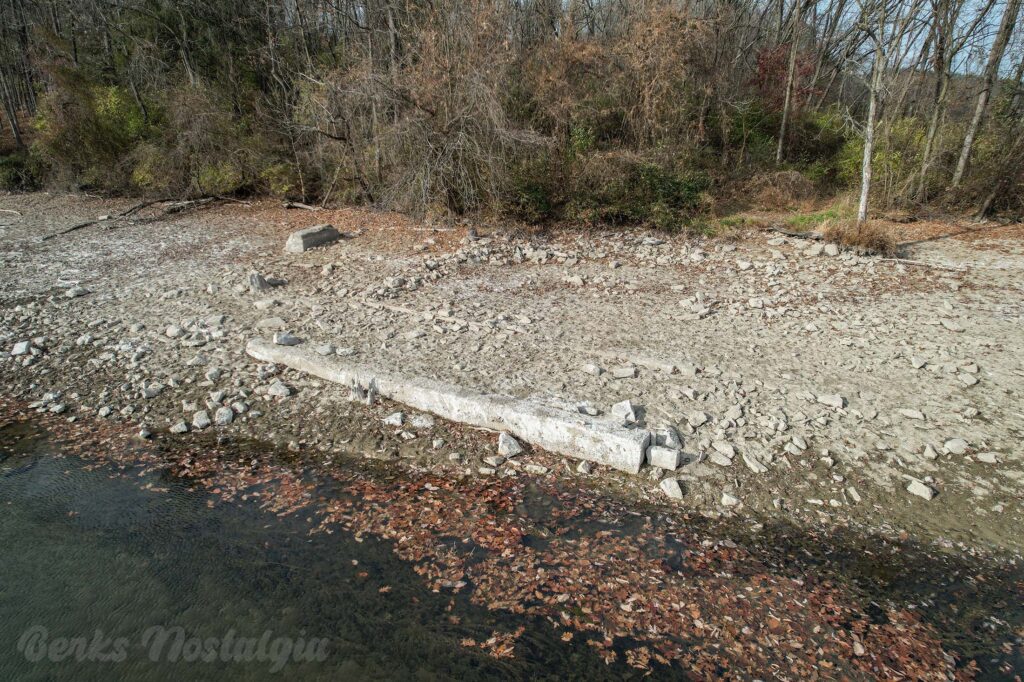
Below is a comparison photo of what I believe to be the same piece of limestone from the ruins of Lamm’s Mill, visible both in my photo and the 1976 LoC photo.
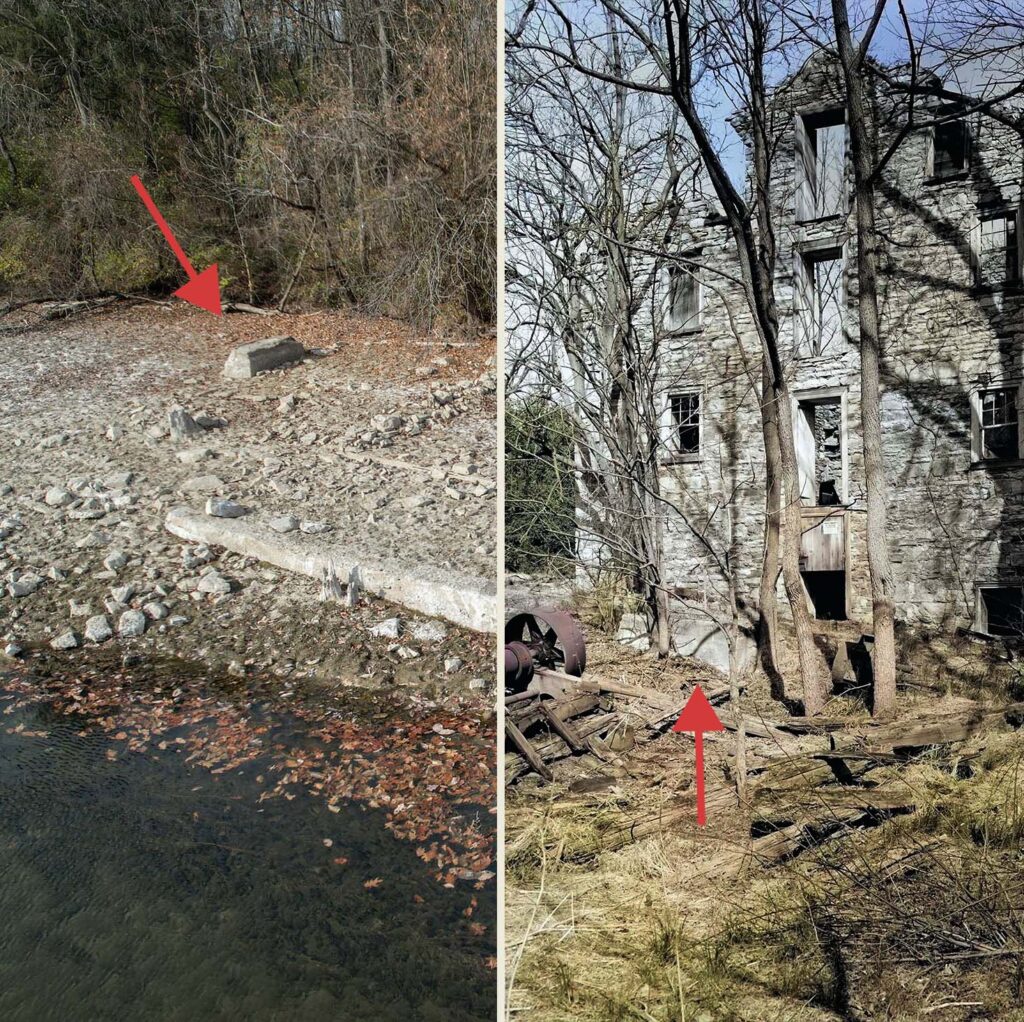
The articles below sum up a few of the happenings around Lamm’s mill in the 19th century. In 1878 fifteen year old Adam Kalbach was standing too close to a shaft when his scarf got caught. I feel a little bad chuckling at the misfortune of Adam, but there is just something amusing about the terminology “whirled around at a frightful velocity“.

The bridge that crossed the Spring Creek near Lamm’s Mill collapsed in April of 1893, when Jacob Speicher was attempting to cross it with a load of hay weighing two and a half tons. Jacob Speicher at the time owned the John Lamm farm mentioned in the first paragraph of this article. It is unclear which bridge this is referring to as there are two bridges in this area as visible below. The Reading Times does not hit the subject again until September 1913 when a grand jury recommended the construction of a new bridge near Lamm’s Mill.
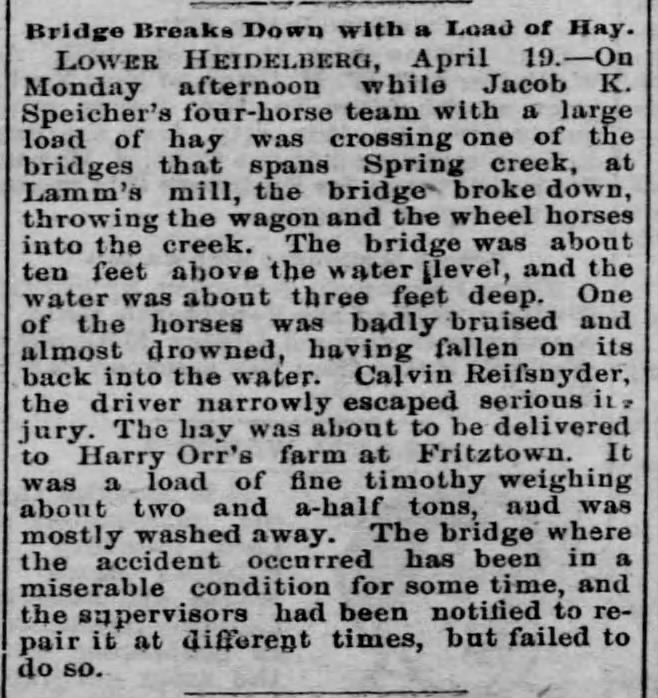
In May of 1889 a band of Gypsies had squatted in the barn on the property.

The footings of what I believe to be the main bridge crossing the Spring Creek is visible in the photo below. Judging by the footings being concrete, this bridge was likely the one replaced in 1913.

The second bridge, which is roughly 500 feet northwest of the bridge pictured above, appeared to be smaller and had stone footings.
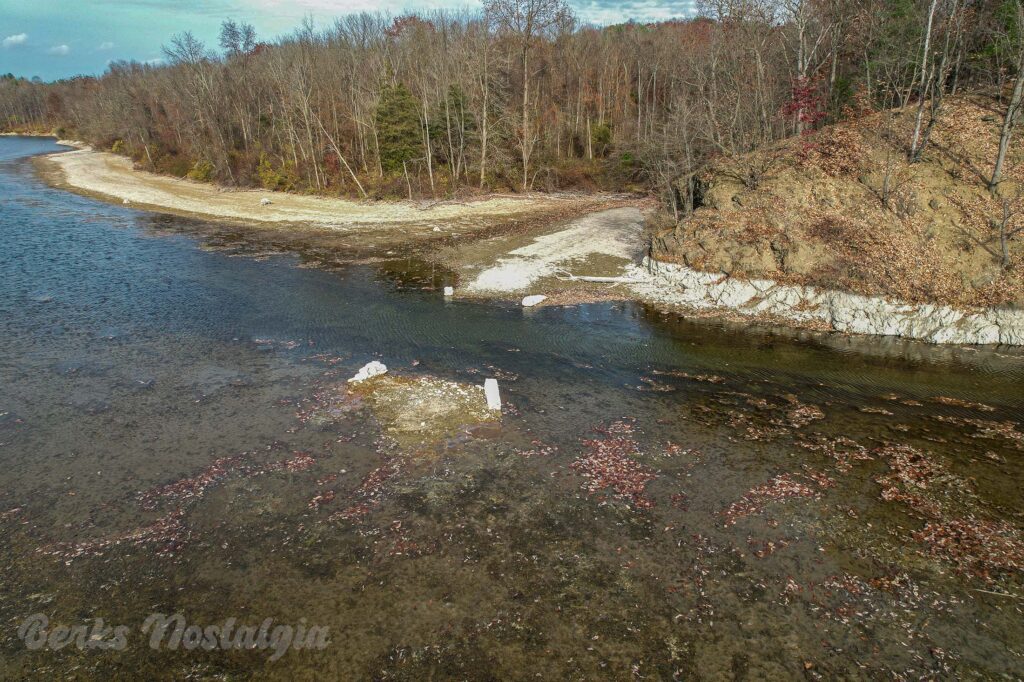
Below is an aerial comparison of the Mill in 1937, around the time it would have been abandoned, and in February 2018, in which all of the remains pictured above are visible. All of these remains are only visible when the lake is drawn down between October – April.
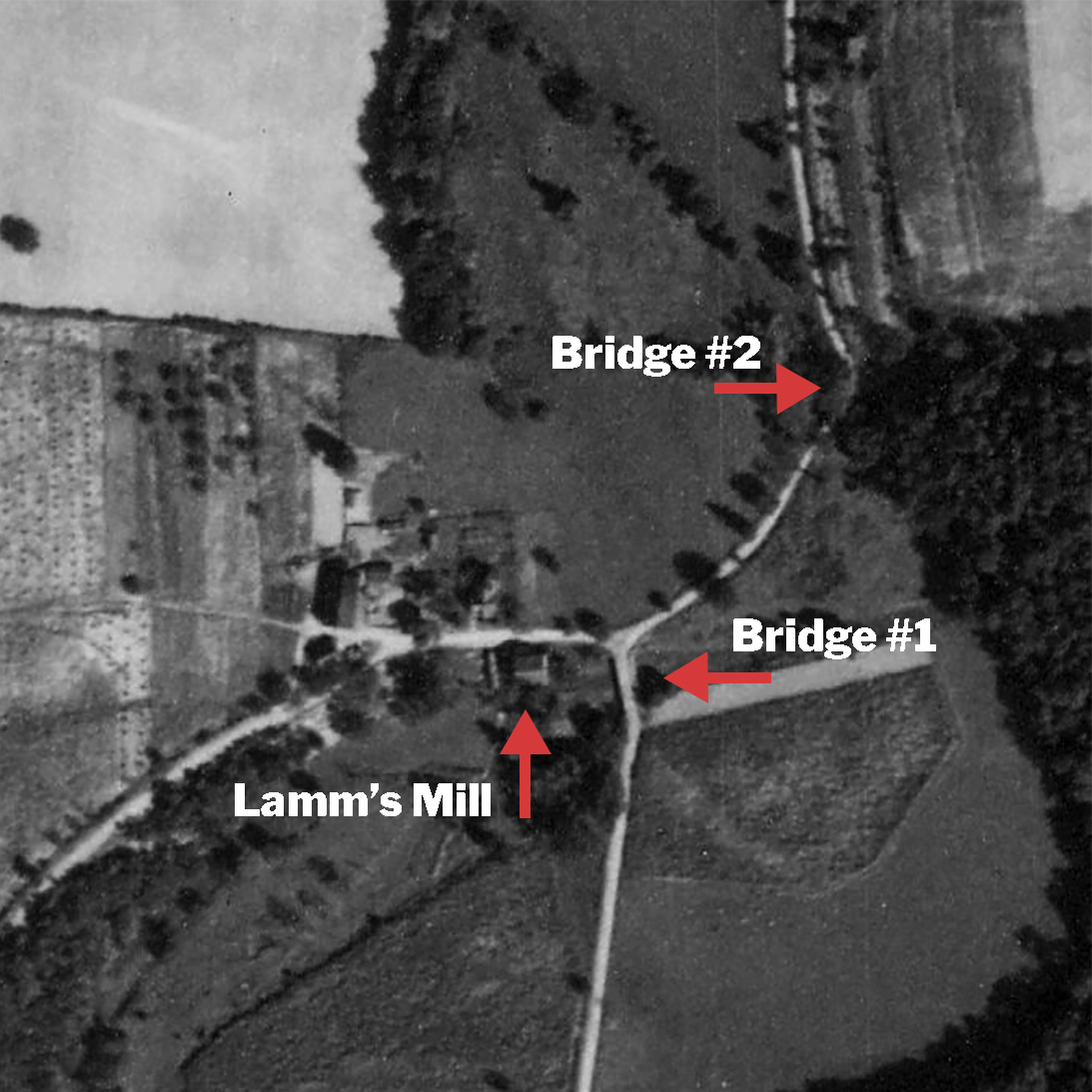
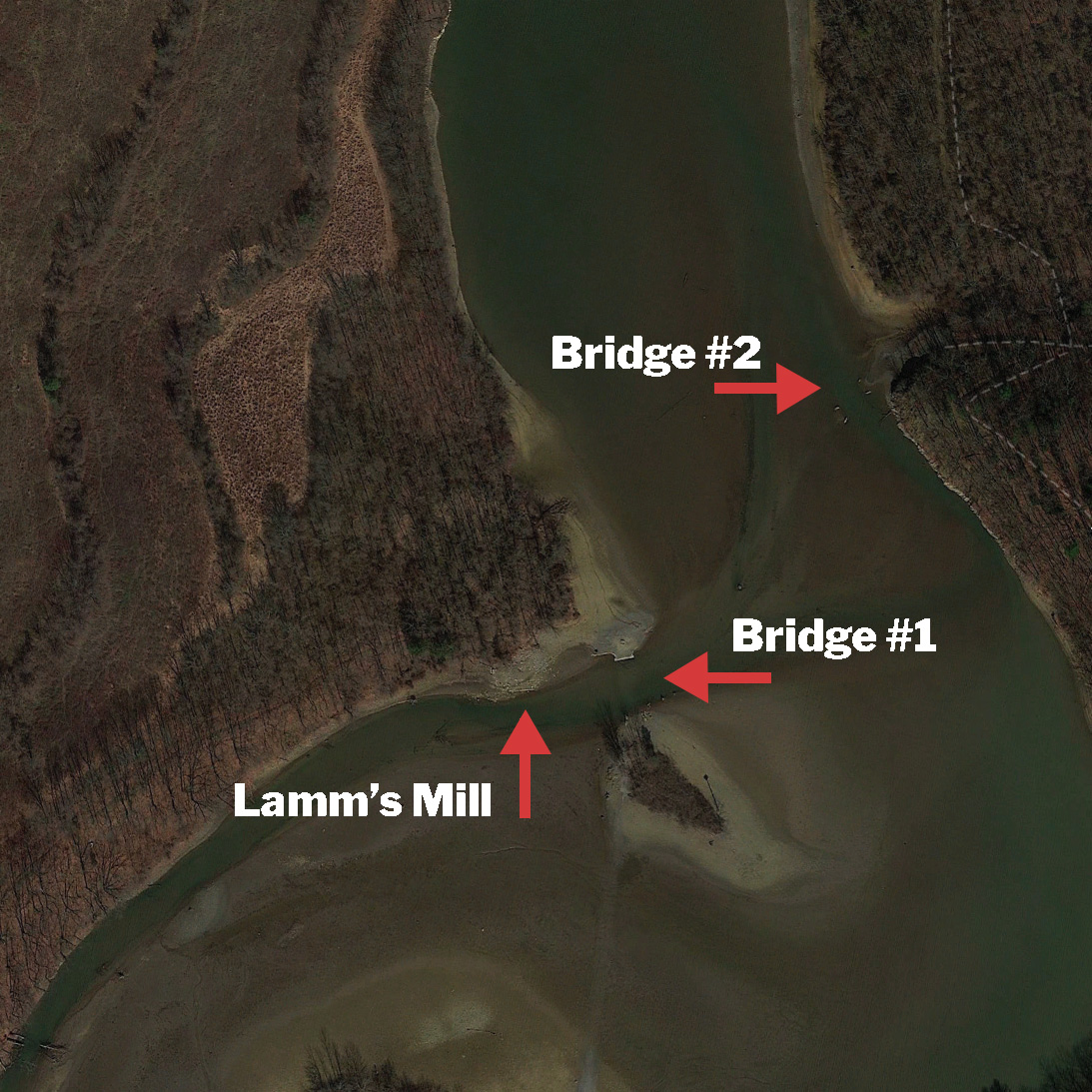


Thank you, Alexa. Your love of history and skill in composing is remarkable. Your articles are concise, organized, and well researched. It is a pleasure to read your work and share in rediscovering these lost landscapes. As a former history teacher, I give you an A+. Once again, well done.
Thanks Robert, I really appreciate your kind words. I truly do love it; the physical exploration to the in-depth research to summarizing my findings. It’s very rewarding to know others enjoy it also!
The sliding aerial comparison photo is brilliant! What a great tool for teaching people about local history with visual media
Thanks Nick, this one is particularly mind blowing, as you can still see the roadways under the water!
Thank you, Alexa. I enjoy your expertise of work and research you have done. I remember those days driving on bridges and roads admiring the beauty we had. In past articles you have posted, for example, the flood of Agnes 1972, I experienced which brought back memories. Living in OK, reading your articles makes me feel back at home. Thank you again.
Thanks, Bobbi. I am sure it was absolutely beautiful. Happy to provide you with a slice of home.
Amazing work. Thank you for taking us on these journeys with you.
I love learning Berks history being a lifelong resident. My family ancestors lived in Berks and your incredible information allows me to experience how my ancestors lived and even read in the Reading newspapers. Thank you.
Love hearing the stories of the valley before it was destroyed. Still have our family home outside of Brownsville but our neighbor’s farm was taken.
Thank You, Alexa, for your wonderful and well-researched articles published for all us history lovers! Being Reading born, raised in W. Berks County during the 50’s & 60’s, I must read every one of your publications. Oh, Nostalgia!
I’m especially thankful for this special one here, as I’m one of Daniel’s many great-great grandchildren. It’ll be saved in the family documentation; currently I’m Genealogist/Historian for the Lamm Family Association.
You might be interested in viewing this old photo of one of Daniel’s sons, John Alfred (my great-grandfather, who BTW, my father strongly favors) As stated in the 1860 census, when aged about 22, his occupation was “Miller.” Thus, your photo postings of the Old Lamm’s Mill are especially dear.
Thanks again,
April Lamm Burwell
Dade City, FL
Hi April, I find it exceptionally rewarding that descendants of these original property owners enjoy these pieces. Thank you for sharing the photo of John. The photos of the mill are available for your own records on the Library of congress website here: https://www.loc.gov/item/pa0103/
If you would like higher resolution copies of my colorized versions, feel free to reach out via email: [email protected]
and of course, thanks for reading!
Thank you Alexa. That’s a great source site. I have another ancestor who was listed as a “Master Miller” in the 1870 Census, residing on the Spring Twp. side of the Tulpehocken Creek. The Library of Congress site helped locate media of these Williams family ancestors during the Civil War. Do you have any archived articles about this area of the Tulpehocken? My maternal Fisher ancestors shown here (late 1800s) lived below Grings Mill, and I’m interested in reading everything you might have documented for the Union Canal. Levi was a canal blacksmith during that era. The 1820 Farm still stands, as does the grape arbor. His smithy shop was still standing up til the last mid century.
When I visited this site several years back while working on our Blue Marsh book, there was still a piece of metal mill machinery embedded in the dirt between what had been the stone outline of the mill. There was also evidence across the old road where the house stood that a millstone had once been embedded in the cement at the bottom of the steps that led up to the mill house. The mill house had also been in an abandoned deteriorated state before the Army Corp took it. The mention of W. Harry Orr’s farm at Fritztown in the old clipping is interesting. Orr was involved with the business Orr and Sembower in Reading. At his show place farm across from Olive Leaf Chapel on Fritztown Road, he raised horses for racing. A track was out back. The stone driveway walls were built as a birthday gift by his wife while he was traveling on business out of country. While building Olive Leaf Chapel, the Orr’s matched money raised dollar for dollar.
Fascinating, Paul. For the first 7 years of my life we lived on Cacoosing Drive on the other side of Wernersville Road from that farm. I always admired that stonework along the driveway, and the horses that would be out grazing. I had no idea that was the Orr farm referenced, its been called “Lutz’s” for as long as I have been around.
You’ve done a great job, Alexa, uncovering remains from these sites and covering their backgrounds.
I found the mention of the Orr farm interesting as well since it was originally part of Henry Shepler Ruth’s land, and I’m one of his many descendants. I’m guessing none of the kids wanted it, and that’s how it landed in Orr’s hands?